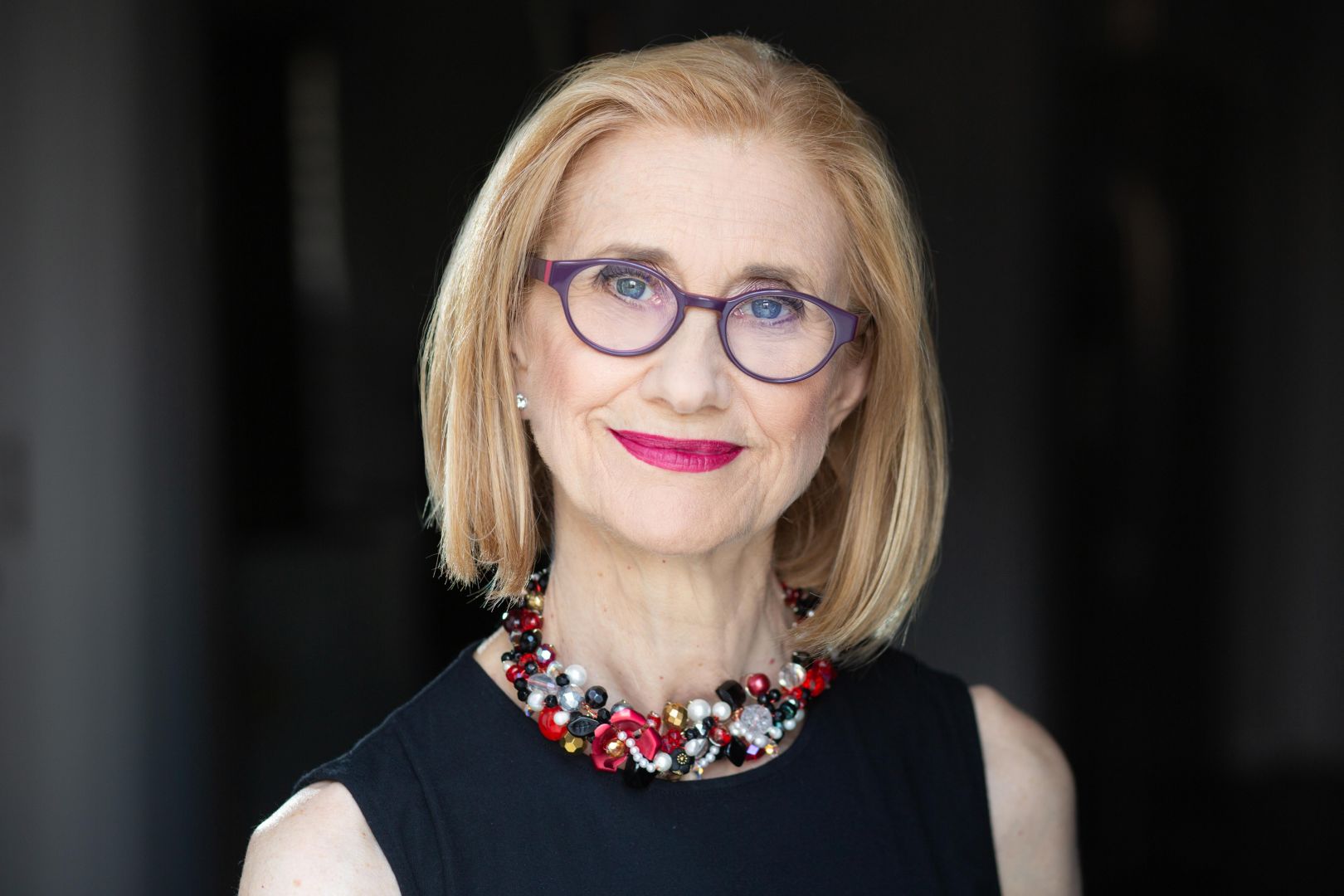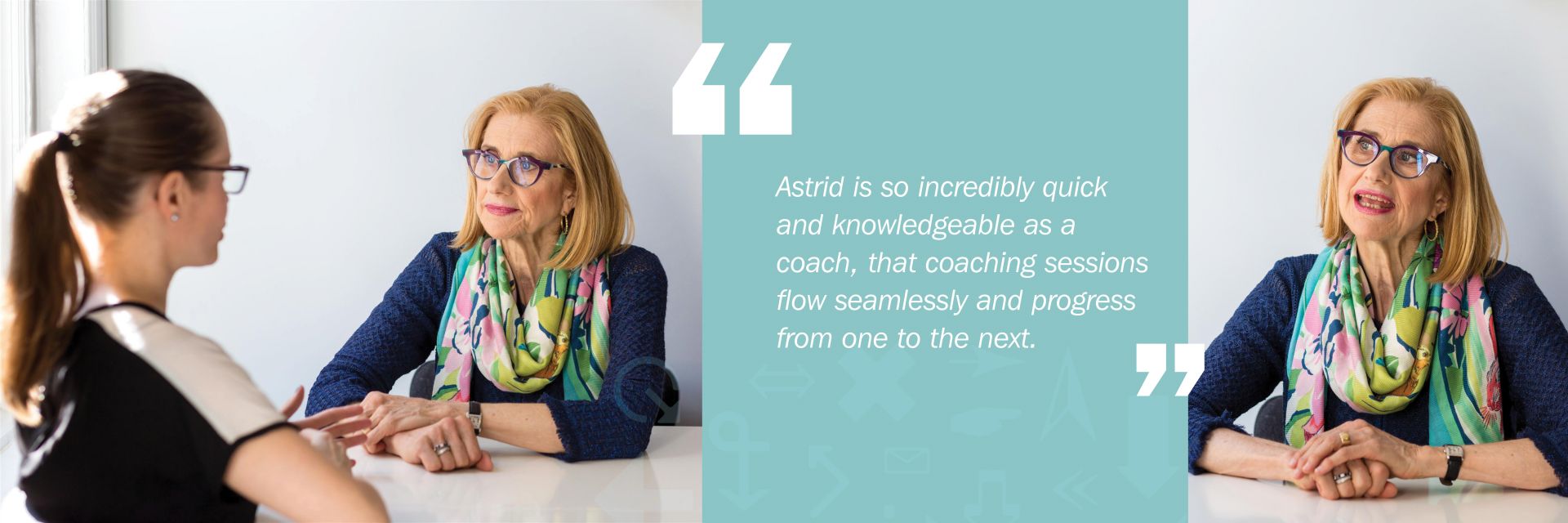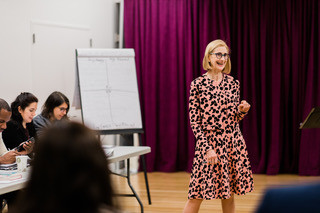Meet Astrid Baumgardner | Executive and Career Coach and Teacher to Arts Leaders, Professional Musicians and Creative Entrepreneurs


We had the good fortune of connecting with Astrid Baumgardner and we’ve shared our conversation below.
Hi Astrid, can you tell us about a book that has had a meaningful impact on you?
I’m a former lawyer turned executive and career coach to creatives and I love what I do!
I coach and train creative leaders and professional musicians and creative entrepreneurs.
I teach collaboration and creativity at Yale University’s School of Music and I guest lecture at arts leadership academies, conservatories and festivals around the country. I’ve written a book and given a TEDx talk on creativity.
Nor I did not start off doing this! My journey from law through the non-profit world and ultimately to my current mix of activities is filled with lot of experiments, detours, risks, mistakes until I ultimately discovered the path that led me to a life fulfillment and holistic success. And my journey was fueled by the field of positive psychology-the science of human flourishing- aptly summarized in the book Happier by Dr. Tal Ben-Shahar. This book introduced me to a brilliant teacher who has had a major impact on my life. It also crystalized principles that have guided my coaching and teaching and have helped me achieve the kind of success that I never thought possible!
Happier by Tal Ben-Shahar
I first heard of Dr. Tal Ben-Shahar when I read an article about his positive psychology class at Harvard: the most popular class at Harvard, with 1400 students studying how to live a life of fulfillment. I did some research on Tal and learned that he had a Ph.D from Harvard in organizational psychology, consulted and lectured to executives in multi-national corporations, governments and educational institutions on leadership and happiness and was a best-selling author. I immediately ordered his book, Happier and knew that I had hit on gold for my own career.
Happier distills the research on the science of happiness and brings the ideas from the academic world to the general reading public. With topics ranging from self-esteem and empathy, to friendship, love, achievement, creativity, spirituality, and humor, the book also emphasizes the importance of taking action steps to translate ideas into action. And it provides exercises and practical tips on how to do so.
One of my favorite concepts from the book was that happiness breeds success: that enjoying what you do while working towards your big goals can enhance your capacity to achieve success. And the research shows that happy individuals enjoy success not only in their careers but also in marriage, friendship, income and health.
This was back in 2010, when my coaching and teaching career were beginning to take off and my coaching method was beginning to come into focus. My approach back then was two-fold: know yourself at your core and what makes you unique—and then go out and make your success happen! This message resonated powerfully with my students and clients in the creative world since creative success is not straight-forward and depends on being positive and proactive. Happier showed me that there was science to back up my method and it validated my approach, as well as provided me new resources to add to my coaching and teaching toolkits.
Armed with this knowledge, my coaching method deepened to include another important aspect of success: your mindset or your attitude on how you see the world. This attitude stems from your life experiences and can lead you to perceive the world somewhere along the spectrum of being a place of opportunity or a place where you can’t make it no matter what. And the good news is that you can change your mindset by reframing your experiences and taking actions to reinforce a more positive way of thinking.
So I began experimenting-taking some risks, if you will!– and introducing into my teaching and coaching concepts from positive psychology including flow and the growth mindset and the research on happiness leading to success. My clients and students loved the results and felt inspired to take charge of their own lives.
Ultimately, my method on how to achieve creative success boiled down to three things:
The right mindset: positive, persevering and proactive;
The authenticity set: values, strengths, passions and purpose; and
The skillsets of success: goals, overcoming the creativity killers, time management, branding, networking, and financial planning.
I call this the Creative Success Now methodology and it’s summarized in my book, Creative Success Now which came out in early 2020, right before the world shut down due to the COVID pandemic.
Happiness Studies Academy
While my plan had initially been to promote my book in 2020, the pandemic shutdown derailed those plans. Fortunately, I was able to continue coaching and teaching thanks to Zoom and I also used the time to prepare and give a TEDx talk on Cracking the Code on Creativity.
Yikes! I accomplished two of my life goals in 2020: to publish a book and to give a TED talk. Now what?
Back to Tal.
I received an email that Tal had left academia and co-founded the Happiness Studies Academy, whose mission is to “lead the happiness revolution, by educating leaders who are themselves dedicated to personal, interpersonal, and communal flourishing.” HSA offered a year-long certificate program to study the science of happiness through an interdisciplinary approach and to learn how to facilitate greater happiness in the world.
I knew that this was my next step so I enrolled in the certificate program in October 2021 and became certified as a Certified Happiness Trainer in August 2022. The program deepened my knowledge and provided me with more resources to share with my clients and students. And it also introduced me to an amazing community of happiness journeyers from around the world through Tal’s weekly live webinars where we had an opportunity to interact with Tal and ask him questions about the science of happiness. Moreover, HSA hosts live retreats where we can meet in person to continue the conversation. So this past October, I traveled to Akumal, Mexico on the Riviera Maya for a Happyning Retreat on the beach with 60 fellow community members—and I finally got to meet Tal! He signed my book and I gave him a copy of my own book. And here we are together in Akumal! (photo).
I feel a renewed sense of excitement as I share the science of happiness with my students and clients. I now have a new offering for creative women leaders: to join my Happiness Connection Community for women who are leading arts organizations and want to embrace greater fulfillment and happiness both for themselves and for the people they lead and interact with. Ultimately, my dream is that we can all spread the happiness revolution and make the world a better place.
Can you open up a bit about your work and career? We’re big fans and we’d love for our community to learn more about your work.
Thanks for asking!
The arts have always been a part of my life. I grew up in a musical household and began studying piano at age 5. So have languages. My parents were post-WWII immigrants from Poland and my first language was Polish. I began studying French when I was in first grade and fell in love with France and French culture, going on to major in French and Spanish in college.
But then it came time to pick a career and I needed something “practical” so I went to law school. I began practicing law in New York City, first at a series of US Firms where I became a partner and then at the New York office of a French law firm where I also became a partner, thus experiencing “success” in the law. But representing corporate clients just did not feel meaningful and was not aligned with my values of relationships, life-long learning and authenticity. Plus, the combative nature of law was inconsistent with my collaborative approach and the analytical way of thinking simply did not represent my more unusual, strategic and creative way of thinking. And, it was challenging to balance the practice of law with my personal life as the mother of two small children.
Once my children were in school, I embarked on the quest to find the right career path. This process involved a lot of fits and starts and taught me a lot of lessons along the way. I started volunteering at a number of arts organizations where I loved collaborating with people who shared my passion for the arts. Those volunteer experiences helped me to transition out of law and into the non-profit world became the deputy executive director of the French Institute Alliance Française of New York City. This was a terrific way to use creative, strategic thinking as well as combine work with my passion for all things French. After three years, I was downsized in a recession. I then became a partner in a start-up consulting firm and left after a year since it was not the right fit. The next step was consulting to nonprofit arts boards but that felt too scattershot. The most fulfilling parts of my life were returning to serious piano lessons with a Juilliard professor, joining a few non-profit arts boards, becoming Chair of the American Composers Orchestra and embracing being the mother of two great kids with a wonderful husband and friends, a daily exercise routine, and an active cultural life. In other words, it was about my relationships and being immersed in the arts in a meaningful way.
What changed in my life was landing up in the hospital for a month in 2007 with a life-threatening illness. For five days, my life hung in the balance. I had four major surgeries and was in a coma for ten days. Then, on my birthday, March 16, I woke up from the coma. I was a true mess: I couldn’t walk, talk, eat, or use my hands—but I knew that I had come back for a reason. And that reason came to me six months later. As I was lying on my couch recovering from surgery number five, I heard a voice that said, “Astrid, you need to get up from that couch and help people with their difficult life transitions.”
That’s how I discovered life coaching: a way to share positivity and courage, to help people transition to a better life. I decided to dedicate my life to coaching creatives because what they do matters to making our world a better place.
Within a month of discovering life coaching, I signed up for coaching school, and six months later, started my coaching business, working with creative lawyers and early-stage professional musicians. I also discovered my passion for teaching. Soon, I was doing career workshops at Juilliard. Whatever I didn’t know, I researched and studied. I solicited feedback, information, and guidance from friends and colleagues. I experimented with different teaching techniques and workshop ideas, and I practiced coaching and teaching on pretty much anyone who would listen.
In 2010, I was invited to guest lecture at the Yale University’s School of Music and a year later, received a dual appointment as a faculty member teaching the entrepreneurship track and as an administrator to create and lead our school’s Office of Career Strategies. I have been at Yale ever since teaching and coaching the next generation of brilliant musicians and passionate cultural leaders. I initially taught the basic music entrepreneurship skills class and since 2015, I have been teaching a design thinking project class to address the big problems facing classical music. In the past two years, my students have worked in collaborative project groups how to advance diversity, equity and inclusion in classical music. One of the class projects became a successful start-up called tonebase where music lovers learn from the world’s greatest musicians, with access to thousands of on-linbetutorials from GRAMMY-award winners, internationally renowned performers and established pedagogues.
I also led the School’s career office for 10 years where I ran workshops, provided individual and group coaching to our students and sponsored speakers and panels of YSM alumni. It is a joy for me to see how well many of our students are doing and I continue to mentor and hear from many of my former students and members of the coaching groups.
In my coaching business, I help individual musicians, arts leaders, and creative professionals achieve their visions of success and fulfillment in their professional, personal and creative lives. My training business has extended to guest lecturing at leading music conservatories and arts leadership training programs. The highlights include OPERA America where I have the privilege of serving as lead faculty to the Leadership Intensive Program for mid-career opera leaders aspiring to take on bigger leadership roles in the arts; Ensemble Connect, the teaching artist ensemble at Carnegie Hall and the League of American Orchestras. I am deeply grateful for the opportunity to help creatives thrive in our changing world and to share the principles of happiness and success so that together, we can assure the vital place of creativity and the arts in our world.
In sum, my long and winding road to professional happiness and success reflects the principles that I share with my clients and students:
Embrace a positive attitude, take risks and learn from your mistakes;
Play to your strengths and align what you do with your values, passions and purpose;
Learn the necessary skills for career success;
Explore and experiments with different alternatives until you find the right fit; and
Keep persevering and never give up!

Any places to eat or things to do that you can share with our readers? If they have a friend visiting town, what are some spots they could take them to?
I live in New York City and am thrilled to live in a vibrant, multi-cultural and diverse place. My week-long itinerary would include: Every day, we would pick a museum and explore the neighborhood around there:
The Metropolitan Museum of Art, by way of a long walk in Central Park;
MOMA: well, skip midtown because it’s too crowded but we would walk over to the Hudson River and check out Bellini at Harry’s Table.
The Whitney (and walk along the Highline and then browse the Chelsea Galleries and stop for a bit to eat in Chelsea Market).
The Tenement Museum and walk around the Lower East Side to see the galleries and have lunch.
The Noguchi Museum and PS1 in Queens and eat at one of the Greek restaurants in Astoria.
The Brooklyn Museum and then hop over to Williamsburg for shopping and lunch.
At night: Choose a concert at Carnegie Hall, the Metropolitan Opera, the new Geffen Hall for a New York Philharmonic Concert. Catch a dance program at the Joyce or at the New York City Ballet. Jazz at the Blue Note in the Village. Have dinner before hand in one of the neighborhood restaurants.
or go to the theater:
Broadway for a Wednesday matinee or an evening show.
Or check out what is happening Off-Broadway.
There would also be a dinner party at my home with my daughter and her husband (both of whom are involved in the contemporary art and design scene) and a few of our chosen friends. I love to cook and my husband and I love to bring interesting people together.

Shoutout is all about shouting out others who you feel deserve additional recognition and exposure. Who would you like to shoutout?
You already have Midnight Oil Collective which is an amazing group that is changing the way artists are compensated.
Here’s another new initiative:
The New Muses Project:
https://newmusesproject.com/about
The New Muses Project is New Muses Project is a DEI-centered classical music organization, promoting justice and curiosity through performance, education, and scholarship. We are driven by a radical desire to always keep learning , as well as strong commitments to intersectionality and depth of understanding. Their objective is to highlight the works of composers whose works have been neglected throughout the ages and deserve to be performed and disseminated.
We have created a platform to make composer recommendations, backed up by a network database of composers and their music, which would be totally comprehensive, well-researched, and equally useful to the performer, scholar, or newcomer. We would plug in all the gaps of missing recordings and transcriptions with our own high-quality publications for maximum accessibility. No composer would be left out. We would change the face of exclusive, inaccesible classical music forever.
To get there, we’ve been hard at work building this web resource and researching hundreds of composers, stepping out of our comfort zones to learn about business, law, and money. We’re really proud of our progress, and we hope that you’ll join us on this journey to make classical music justice-focused and curiosity-driven.
Website: https://www.astridbaumgardner.com
Instagram: astridlrb
Linkedin: https://www.linkedin.com/in/astridbaumgardner/
Twitter: @abaumgardner
Facebook: https://www.facebook.com/astrid.baumgardner/
Image Credits
David Perlman Photography for the headshot Rachel Rodgers for the picture of me teaching
